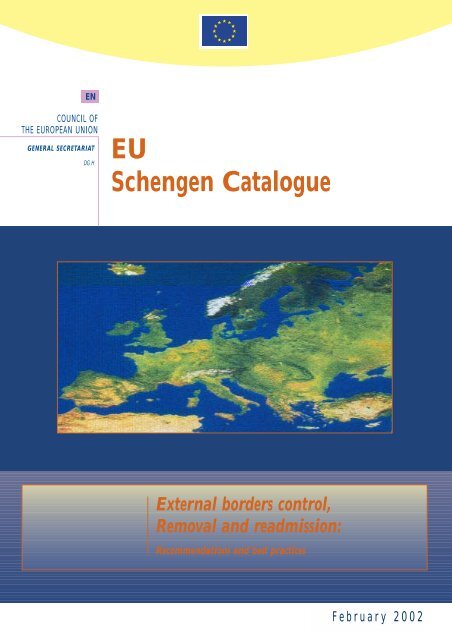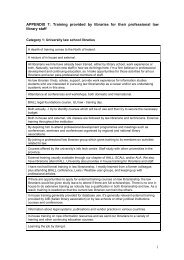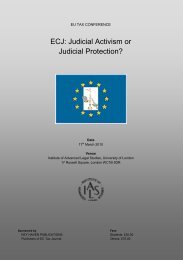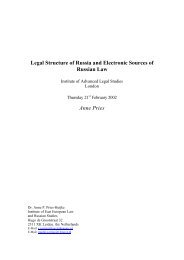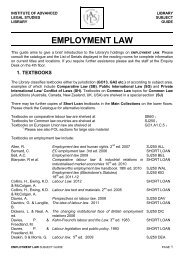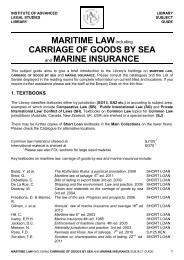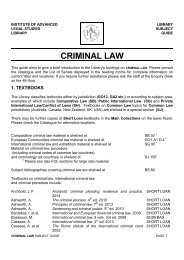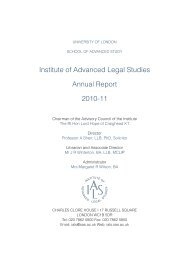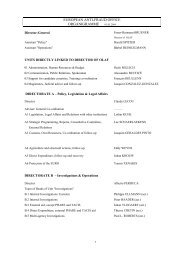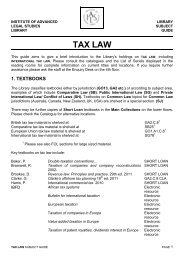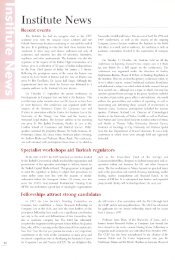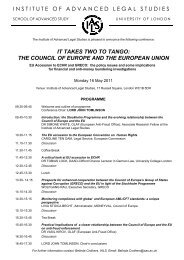EU Schengen Catalogue
EU Schengen Catalogue
EU Schengen Catalogue
Create successful ePaper yourself
Turn your PDF publications into a flip-book with our unique Google optimized e-Paper software.
EN<br />
COUNCIL OF<br />
THE <strong>EU</strong>ROPEAN UNION<br />
GENERAL SECRETARIAT<br />
DG H<br />
<strong>EU</strong><br />
<strong>Schengen</strong> <strong>Catalogue</strong><br />
External borders control,<br />
Removal and readmission:<br />
Recommendations and best practices<br />
February 2002
<strong>EU</strong><br />
<strong>Schengen</strong> <strong>Catalogue</strong><br />
External borders control,<br />
Removal and readmission:<br />
Recommendations and best practices
PREFACE BY MARIANO RAJOY BREY,<br />
FIRST DEPUTY PRIME MINISTER AND MINISTER FOR THE INTERIOR OF SPAIN,<br />
PRESIDENT-IN-OFFICE OF THE COUNCIL OF THE <strong>EU</strong>ROPEAN UNION<br />
Spain, which has held the Presidency of the Council of the European Union since 1 January this<br />
year, is giving priority treatment to the enlargement of the European Union to include the candidate<br />
countries, which is the cornerstone of European integration.<br />
The building of a common area of freedom, security and justice and the creation of the <strong>Schengen</strong><br />
area occupy a prominent place in the process of consolidating and strengthening the Union and<br />
raising the profile of its institutions, not only internally in relation to the citizens of Europe, but also<br />
externally, in relation to the candidate countries, enabling them to acquaint themselves with the<br />
legal and institutional framework which constitutes the acquis in Justice and Home Affairs (JHA).<br />
In the same effort to clarify and highlight the requirements which the candidate countries will be<br />
called upon to meet on accession, we are presenting to them today, at this Joint Council meeting,<br />
this "<strong>Catalogue</strong> of recommendations for the correct application of the <strong>Schengen</strong> acquis and best<br />
practices".<br />
The <strong>Catalogue</strong> has been drawn up by the Working Party on <strong>Schengen</strong> Evaluation, at the initiative of<br />
Belgium and with the assistance of experts of various nationalities who have pooled their<br />
knowledge so as to achieve a result which can be pronounced highly commendable. At present the<br />
<strong>Catalogue</strong> refers exclusively to border control and expulsion and readmission procedures, without<br />
prejudice to the work which successive Presidencies carry out in other fields such as visas,<br />
SIS/SIRENE, police cooperation, etc.<br />
The purpose of the <strong>Catalogue</strong> is explanatory and it has no legally binding status. It shows, set out in<br />
separate columns, on the one hand, the levels which may be required in order to comply with the<br />
acquis and, on the other, the best practices already being recorded in some of the Member States,<br />
although, however desirable, they are not mandatory at present.<br />
It is with great satisfaction that the Council of the European Union presents this working tool,<br />
which is intended to dispel the uncertainties to which introduction of the <strong>Schengen</strong> acquis gives rise<br />
in practice. The Spanish Presidency is confident that the <strong>Catalogue</strong> will constitute an additional<br />
instrument for ensuring the successful integration of the Union's new members in due time and in<br />
the appropriate manner.<br />
Mariano Rajoy Brey<br />
Brussels, 28 February 2002<br />
3
TABLE OF CONTENTS<br />
INTRODUCTION ...............................................................................................................................7<br />
PART ONE: BORDERS, BORDER SURVEILLANCE AND BORDER CONTROL<br />
A. Integrated border security model (a mechanism of different tiers/filters).............................11<br />
1. Introduction ..............................................................................................................................................11<br />
2. The four tiers.............................................................................................................................................12<br />
3. Key elements for the correct application of the Integrated Border Security Model ..........................16<br />
B. Details of recommendations and best practices......................................................................18<br />
Recommendations/Best practices .......................................................................................................................18<br />
1. Strategy and organisational structure ....................................................................................................18<br />
2. Infrastructure............................................................................................................................................23<br />
3. Staff............................................................................................................................................................27<br />
4. Training.....................................................................................................................................................28<br />
5. Equipment.................................................................................................................................................30<br />
6. Internal coordination ...............................................................................................................................33<br />
7. Different kinds of international cooperation..........................................................................................34<br />
8. Rules and procedures ...............................................................................................................................36<br />
9. Particular cases for certain types of border ...........................................................................................38<br />
PART TWO: REMOVAL AND READMISSION<br />
1. Introduction .............................................................................................................................................48<br />
2. Removal measures ....................................................................................................................................49<br />
3. Persons concerned ...................................................................................................................................50<br />
4. Implementation of removal measures.....................................................................................................51<br />
5
SCHENGEN CATALOGUE<br />
INTRODUCTION<br />
1. At its meeting on 28 May 2001, the Council set as an objective for further work by the<br />
Working Party on <strong>Schengen</strong> Evaluation the identification of "... best practices, particularly as<br />
regards border controls, so that they can serve as examples for those States acceding to<br />
<strong>Schengen</strong> but also those fully applying the <strong>Schengen</strong> acquis. These evaluations and the<br />
identification of best practices shall serve as inspiration for the establishment of standards<br />
defining the minimum application of the <strong>Schengen</strong> acquis (e.g. essential equipment at each<br />
border post) in the relevant working groups" (mandate for the Working Party on <strong>Schengen</strong><br />
Evaluation) (8881/01 – SCH-EVAL 17, COMIX 371).<br />
On the basis of this mandate, the Working Party on <strong>Schengen</strong> Evaluation worked out the<br />
principles and procedure for drawing up the <strong>Catalogue</strong> of recommendations for the correct<br />
application of the <strong>Schengen</strong> acquis and best practices, hereinafter referred to as the <strong>Catalogue</strong><br />
of recommendations and best practices, or <strong>Catalogue</strong>.<br />
The purpose of the <strong>Catalogue</strong> is to clarify and detail the <strong>Schengen</strong> acquis and to indicate<br />
recommendations and best practices, in order to provide an example for those States acceding<br />
to <strong>Schengen</strong> and also those fully applying the <strong>Schengen</strong> acquis. With this in mind the<br />
<strong>Catalogue</strong> gives a good indication to the candidate countries for accession to the European<br />
Union (hereinafter referred to as the "<strong>EU</strong>") (at their request) as to what is expected of them,<br />
particularly in practical terms, regarding <strong>Schengen</strong>. The aim is not to give an exhaustive<br />
definition of the whole of the <strong>Schengen</strong> acquis but to put forward recommendations and best<br />
practices in the light of the experience gained by the Working Party on <strong>Schengen</strong> Evaluation<br />
in verifying the correct application of the <strong>Schengen</strong> acquis in Germany and in evaluating<br />
Greece and the Nordic countries.<br />
The text of the <strong>Catalogue</strong> does not seek to introduce new requirements but should also make it<br />
possible to draw the Council's attention to the need where appropriate to amend certain<br />
provisions of the <strong>Schengen</strong> acquis so that the Commission and, where appropriate, the<br />
Member States take the recommendations and best practices into account when putting<br />
forward proposals or formal initiatives. This exercise is inter alia the first stage of the process<br />
of defining minimum standards by the Council.<br />
7
Moreover, the <strong>Catalogue</strong> will serve as a reference tool for future evaluations undertaken in the<br />
candidate countries. It will therefore also serve as an indicator for these countries of the tasks<br />
which they will be assigned and in this respect should be read in conjunction with the<br />
Common Manual.<br />
2. The Working Party on <strong>Schengen</strong> Evaluation adopted the following definitions to conduct this<br />
exercise:<br />
recommendations: non-exhaustive series of measures which should make it possible to<br />
establish a basis for the correct application of the <strong>Schengen</strong> acquis and for monitoring it.<br />
best practices: non-exhaustive set of working methods or model measures which must be<br />
considered as the optimal application of the <strong>Schengen</strong> acquis, it being understood that several<br />
best practices are possible for each specific part of <strong>Schengen</strong> cooperation.<br />
3. Where the <strong>Catalogue</strong> mentions the Member States which apply the <strong>Schengen</strong> acquis, this is<br />
currently to be taken as meaning the thirteen Member States of the <strong>EU</strong> referred to in Article 1<br />
of the Protocol integrating the <strong>Schengen</strong> acquis into the framework of the <strong>EU</strong> annexed to the<br />
Treaty on European Union and to the Treaty establishing the European Community<br />
(hereinafter the "<strong>Schengen</strong> Protocol"), to which must be added Iceland and Norway, pursuant<br />
to the Agreement concluded by the Council of the European Union, the Republic of Iceland<br />
and the Kingdom of Norway concerning the latters' association with the implementation,<br />
application and development of the <strong>Schengen</strong> acquis, signed on 18 May 1999 (these 15 States<br />
are hereinafter referred to as the "<strong>Schengen</strong> States").<br />
The United Kingdom and Ireland expressed the wish to participate in certain provisions of the<br />
<strong>Schengen</strong> acquis. The Council has not yet adopted a decision on Ireland's request to<br />
participate. The arrangements for the United Kingdom's participation were adopted in the<br />
Council Decision of 29 May 2000 (2000/365/EC). The Council has not yet decided on the<br />
implementation of the provisions in question.<br />
The <strong>Schengen</strong> acquis and the other measures taken by the institutions within the scope of the<br />
acquis are, under Article 8 of the <strong>Schengen</strong> Protocol, regarded as an acquis which must be<br />
accepted in full by all States candidates for accession.<br />
4. The <strong>Schengen</strong> acquis was integrated into the <strong>EU</strong> framework by the <strong>Schengen</strong> Protocol. The<br />
extent of the acquis is defined in Council Decision 1999/435/EC, published in OJ L 176 of<br />
10 July 1999.<br />
8
Since its integration into the <strong>EU</strong>, the <strong>Schengen</strong> acquis has undergone developments and<br />
amendments which lend it an evolutionary character.<br />
The <strong>Schengen</strong> acquis has also taken on board the results of the evaluations which have been<br />
conducted within the framework of the Standing Committee for the application and evaluation<br />
of the <strong>Schengen</strong> acquis, now called the "Working Party on <strong>Schengen</strong> Evaluation". Under the<br />
Working Party's mandate, reports are submitted to the Council to establish whether the<br />
conditions required for the entry into force of the provisions of the <strong>Schengen</strong> acquis in a<br />
country wishing to participate in those provisions (or in some of them) have been met and,<br />
secondly, to monitor the correct application of the <strong>Schengen</strong> acquis by the <strong>Schengen</strong> States, in<br />
particular by detecting problems and proposing solutions.<br />
5. The current <strong>Catalogue</strong> deals primarily with the issues of borders and removal. Free<br />
movement as introduced within the territory of the <strong>Schengen</strong> States (this term and the<br />
expression "<strong>Schengen</strong> States" refer to the territory of the <strong>Schengen</strong> States in which the<br />
<strong>Schengen</strong> acquis applies) is a freedom which as a counterpart requires the strengthening of the<br />
external borders of that area and a policy for the removal of illegally resident aliens which is<br />
effective and dissuasive. The fight against illegal immigration is a major preoccupation for<br />
the whole of the <strong>EU</strong>. It is indeed this double axiom which guides <strong>EU</strong> action in this sphere.<br />
Accordingly, the measures adopted in this context seek to strengthen European integration<br />
and in particular to enable the <strong>EU</strong> to become more rapidly an area of freedom, security and<br />
justice.<br />
6. The <strong>Catalogue</strong> refers to ideas or concepts connected with the administration of borders, the<br />
terms of which are not uniformly defined or codified in the <strong>Schengen</strong> States. In the interests<br />
of ease of understanding, the following definitions apply to the terms used:<br />
a. Integrated Border Security Model: name of the system covering all aspects of border<br />
policy. This system is spread over four complementary tiers (filters) which are:<br />
activities in third countries, countries of origin and transit, bilateral and international<br />
cooperation, measures at the external borders and further activities inside the territory.<br />
9
. Border Management: this concept covers both the surveillance of borders and checks,<br />
the latter being defined in Article 6 of the <strong>Schengen</strong> Convention:<br />
• Border checks: checks carried out at authorised crossing points. It should be<br />
noted that checks on persons shall include not only the verification of travel<br />
documents and the other conditions governing entry, residence, work and exit but<br />
also checks to detect and prevent threats to the national security and public policy<br />
of the <strong>Schengen</strong> States. Such checks shall also be carried out on vehicles and<br />
objects in the possession of persons crossing the border.<br />
• Border surveillance: surveillance carried out between authorised crossing points.<br />
7. In the <strong>Catalogue</strong> the reader will find the following sections: the <strong>Catalogue</strong> currently comprises<br />
two main chapters, one on borders and the other on removal. A general section describes the<br />
basic concepts underlying the policy and is followed by recommendations and best practices<br />
presented in tabular form, with recommendations on the left and best practices on the right,<br />
alongside the relevant recommendations. Where one of these recommendations applies only<br />
to one or two types of border this is mentioned in the text.<br />
* * *<br />
10
PART ONE : BORDERS, BORDER SURVEILLANCE AND BORDER CONTROL<br />
A. INTEGRATED BORDER SECURITY MODEL (A MECHANISM OF DIFFERENT<br />
TIERS/FILTERS)<br />
1. INTRODUCTION<br />
An overall border model is an important tool to safeguard internal security and in particular<br />
prevent illegal immigration. It means in simplified terms that a set of complementary<br />
measures has to be implemented on different tiers. In this respect four tiers can be identified.<br />
(1) Activities in third countries, especially in countries of origin and transit, including the<br />
collection of information by liaison officers as well as the key role of the consular post<br />
abroad in the process of issuing visas.<br />
(2) International border cooperation.<br />
(3) Measures at external borders: border management (border checks and border<br />
surveillance).<br />
(4) Further activities inside the territory of the <strong>Schengen</strong> States and between <strong>Schengen</strong><br />
States.<br />
The coherence between these measures and the way they are applied by <strong>Schengen</strong> States is a<br />
key to the success of the general border model.<br />
11
2. THE FOUR TIERS<br />
2.1. Activities in third countries, in countries of origin and transit<br />
(a)<br />
The first measure required in terms of time and place is advice from liaison<br />
officers and document experts in third countries of origin or transit which are the<br />
source of the risks generated by illegal immigration (Article 47 (4) of the 1990<br />
Convention implementing the <strong>Schengen</strong> Agreement (hereafter the "<strong>Schengen</strong><br />
Convention") and SCH/Com-ex (98) 59 rev). Officials working abroad for the<br />
<strong>Schengen</strong> States' consular posts and carriers will be trained by specialists in order<br />
to detect document forgeries before actual travel has started.<br />
When visas are issued and when passengers are transported by air and sea, it is of<br />
great importance to detect false and falsified documents in order to prevent<br />
unauthorised entry into the territory of the <strong>Schengen</strong> States. The training given by<br />
document advisers makes a vital contribution to the detection of such forgeries by<br />
officials working for the <strong>Schengen</strong> States' consular posts and for carriers.<br />
(b)<br />
In the second stage, a thorough inspection of the application documents submitted<br />
should be carried out by the <strong>Schengen</strong> States' consular representations when<br />
issuing visas (see Articles 15 and 17 of the <strong>Schengen</strong> Convention and the<br />
provisions of the Common Consular Instructions on Visas). This includes<br />
inspecting documents and making database queries pursuant to Article 96 of the<br />
<strong>Schengen</strong> Convention. Consulates should guarantee that sensitive information<br />
and blank documents are adequately protected and stored.<br />
The systematic implementation of EC/<strong>Schengen</strong> visa regulations should enable<br />
the phenomenon of illegal immigration to be effectively tackled at its roots. The<br />
importance of intensive consular cooperation should be stressed in that context.<br />
12
(c)<br />
Carriers are also obliged pursuant to national legislation on the basis of<br />
Article 26(1)(b) of the <strong>Schengen</strong> Convention to take all necessary measures to<br />
ensure that third-country nationals carried by air, sea or land, (see Article 26(3) of<br />
the <strong>Schengen</strong> Convention), have the travel documents necessary for entry into the<br />
territory of the <strong>Schengen</strong> States. If third-country nationals are set down in a<br />
<strong>Schengen</strong> State without the prescribed documents, the carriers will be subject to<br />
sanctions and compelled in principle to take back those passengers. Staff of<br />
carriers should be trained. This article of the <strong>Schengen</strong> Convention has been<br />
supplemented by Directive 2001/51/EC of 28 June 2001 – L 187, 10.7.2001,<br />
p. 45.<br />
2.2. Bilateral and international border Cooperation<br />
(a)<br />
International co-operation in the field of border security can be divided into<br />
multilateral, bilateral and local cooperation. In this respect, agreements with<br />
neighbouring countries on the cooperation in the field of border management are<br />
an efficient tool to increase border security. This can be realised by establishing<br />
appropriate working mechanisms such as exchange of information, establishing<br />
appropriate communication channels, local contact points, emergency procedures,<br />
handling incidents in an objective manner in order to avoid political disputes, etc.<br />
Regional cooperation structures across external borders should also be established<br />
in sea areas. These initiatives should bring together all countries in the region.<br />
(b)<br />
As regards cooperation with adjacent states, it is considered necessary that transit<br />
states lend their active assistance by ensuring that their borders are thoroughly<br />
secure and by taking measures away from the border, i.e. consistent repatriation<br />
practice – if there is no right of admission and there are no impediments based on<br />
serious humanitarian grounds or international law (e.g. the Geneva Convention<br />
relating to the Status of Refugees, European Convention on Human Rights).<br />
13
2.3. Measures at the external borders<br />
The core area of general border strategy is a functioning border management consisting<br />
of border checks and border surveillance, based on a risk analysis. Article 6 of the<br />
<strong>Schengen</strong> Convention sets out clearly the framework to be implemented by the<br />
Common Manual, the two being complementary. Essential elements of border<br />
management are: (1) that all persons crossing the external borders are checked<br />
systematically and (2) effective border surveillance is ensured between border crossing<br />
points.<br />
In this respect all appropriate measures should be taken in order to safeguard internal<br />
security and prevent illegal immigration:<br />
Coherent legislation based on the EC/<strong>Schengen</strong> requirements in the area of border<br />
management is needed (for example: border guard act, data protection rules). With<br />
regard to infrastructure, appropriate facilities for carrying out border checks and<br />
surveillance have to be available. Officials carrying these tasks have to be professional<br />
and specially trained. Adequate human resources are required. Exact requirements<br />
depend on several factors (geographical situation, volume of border traffic, etc.).<br />
Moreover, a clear concept of training (basic and further) is required covering<br />
operational skills, knowledge of legislation, languages, etc.<br />
Equipment should be appropriate to the border situation. Functioning internal<br />
coordination is needed at all levels (which authorities are competent for which task, no<br />
competence "black holes"). Information exchange between competent authorities<br />
(border guard, customs, police, judicial authorities, prosecutors) is essential, including a<br />
mechanism to solve possible disputes of competence between the authorities.<br />
Furthermore, operational issues should be covered (for example use of compatible<br />
communication equipment).<br />
14
Agreed international/bilateral cooperation should be implemented in practice on the<br />
spot (examples: exchange of information, joint controls, handling of readmission<br />
situations). The special requirements for the three different types of border (air,<br />
sea, land) should be fulfilled (for example: at airports a separation of passenger flows –<br />
extra <strong>Schengen</strong> and intra <strong>Schengen</strong> flights – should be made by physical means or, for<br />
minor airports, by a systematically monitored and accompanied flow of passengers).<br />
2.4. Further activities inside the territory of the <strong>Schengen</strong> States<br />
(a)<br />
Measures to prevent illegal immigration and cross-border crime should be pursued<br />
inside the territory of the <strong>Schengen</strong> States by enhanced search, checks and<br />
surveillance measures based on national information and in accordance with<br />
national law, where possible on the basis of police cooperation agreements<br />
pursuant to Article 39(4) and (5) of the <strong>Schengen</strong> Convention. Given that the<br />
problems of migration and crime are not subject to geographical restrictions,<br />
international traffic routes should in future become main areas of activity for<br />
national police forces in accordance with domestic law. However, where public<br />
policy or national security so require, a <strong>Schengen</strong> State may, after consulting the<br />
other <strong>Schengen</strong> States, decide that for a limited period national border checks<br />
appropriate to the situation shall be carried out at internal borders.<br />
(b)<br />
The last stage in the geographical and time sequence is repatriation in accordance<br />
with national law (see Article 23 of the <strong>Schengen</strong> Convention and Directive<br />
2001/40/EC of 28 May 2001 - L 149, 2.6.2001, p. 34) of third-country nationals<br />
who have entered the <strong>Schengen</strong> territory without authorisation, if no right to stay<br />
exists and if there are no obstacles based on compelling humanitarian grounds or<br />
international law (e.g. the Geneva Convention on Refugees, European Convention<br />
on Human Rights).<br />
15
3. KEY ELEMENTS FOR THE CORRECT APPLICATION OF THE INTEGRATED BORDER SECURITY<br />
MODEL<br />
Emphasis should be placed on the coordination of duties between the responsible government<br />
bodies in dealing with information, reports and training and in responding to irregularities.<br />
Coordination in these fields should extend to regional and local levels too.<br />
Another key element of the method is to pay attention to the assessment of the situation.<br />
Thus, the performance of a border management system should be adjusted in accordance with<br />
the prevailing conditions along all its borders. Valid and reliable data should form part of a<br />
permanent evaluation which could be shared by other <strong>Schengen</strong> States. Where necessary, the<br />
allocation of resources should be adapted accordingly.<br />
As a general rule, persons performing border police duties should be specialised trained<br />
professionals. Persons with less experience can be used only for auxiliary duties assisting<br />
professionals temporarily. No exception is allowed in respect of duties that require any use of<br />
personal data, making searches in confidential registers or decisions interfering with an<br />
individual's physical integrity or freedom.<br />
To facilitate mutual trust, any <strong>Schengen</strong> State should be able to provide valid and reliable data<br />
concerning the situation at all its borders and also the border checks and surveillance<br />
measures applied. Knowledge of the situation at the border relies on knowledge of the<br />
performance of border management systems. Reliable estimates concerning border checks<br />
and surveillance measures should be based, among other things, on complete knowledge of<br />
regional and local circumstances. To attain the above aims and to facilitate cost-effective use<br />
of resources, various methodologies should be applied at the borders. Terms such as risk<br />
analysis, intelligence, data-flow management, situational awareness, reaction capability and<br />
information exchange with other <strong>Schengen</strong> States can be used when evaluating and<br />
developing these methods.<br />
16
Risk analysis can be seen as a tool for optimisation of border management and a way of<br />
providing reliable information on the border situation. It should be adapted to the type of<br />
borders.<br />
At practical level this means evaluation of the persons, vehicles, vessels or flights to be<br />
checked. This evaluation is made in the context of a real time tactical situation and thus the<br />
methods can be called tactical risk analysis. At the external border, all persons should be<br />
checked according to the Common Manual. To detect cross-border crime, extra emphasis<br />
should be placed on the checking procedure for suspect objects. Personnel should be<br />
provided with knowledge of risk indicators, risk profiles and typical modi operandi of<br />
cross-border crime. Named special targets of surveillance and checks should also be known<br />
to personnel. The risk analysis and management of borders need to be backed by systematic<br />
intelligence. Border management systems should be able to gather intelligence, analyse it<br />
and, finally, utilise the products in field work.<br />
To have a realistic picture of prevailing irregularities for the purposes of medium and<br />
long-term operative management, estimates should be made of:<br />
●<br />
●<br />
●<br />
the level of risk defined by the authorities in respect of illegal crossing of the border<br />
the level of detected irregularities<br />
the level of estimated undetected irregularities.<br />
This is to ensure that resources will be allocated optimally along the border in order to<br />
maintain a reasonable risk level in respect of illegal crossing of the border. Further, at all<br />
managerial levels, the management system should be evaluated in order to find out<br />
shortcomings or gaps in the system. These exist where a border can predictably be crossed<br />
illegally with very low risk or no risk at all.<br />
17
B. DETAILS OF RECOMMENDATIONS AND BEST PRACTICES<br />
RECOMMENDATIONS/BEST PRACTICES<br />
Recommendations<br />
Best practices<br />
1 Strategy and organisational structure<br />
1.1 general strategy for border<br />
management + risk assessment<br />
- establishing a national plan defining the<br />
steps to be taken in the countries of<br />
origin and transit, at external <strong>Schengen</strong><br />
borders and inside the individual<br />
<strong>Schengen</strong> States<br />
- border management is a task which<br />
requires a high level of professionalism<br />
- streamlined and functional ministerial<br />
competences for border management.<br />
Centralised supervision and instructions<br />
for border checks and surveillance<br />
under the auspices of a ministry<br />
working in the field of justice and home<br />
affairs.<br />
- the competent public authority is a<br />
specialised Police/Border Guard force<br />
(not a military force)<br />
- effective border management is ensured<br />
by supplementing strategy with<br />
technology, equipment and staff;<br />
mobile and stationary, airborne or on<br />
land/sea, uniformed or plain clothed.<br />
- border checks and surveillance should be<br />
executed by professional officials of the<br />
same administration organising border<br />
management if possible under a single<br />
national ministry.<br />
18
Recommendations<br />
- permanent analysis determines the<br />
allocation of personnel and technical<br />
resources;<br />
Best practices<br />
- an evaluation is to be made to ensure<br />
that border management matches the<br />
requirements of Article 6 of the<br />
<strong>Schengen</strong> Convention and to consider<br />
whether border management has to be<br />
adapted. Article 7 requires exchange of<br />
all relevant information.<br />
- at international level border<br />
management should be governed by<br />
bilateral agreements<br />
- cooperation and coordination of the<br />
responsibilities of the different bodies<br />
should be regulated by an official Act<br />
1.2 Intelligence and data-flow<br />
management<br />
These agreements/Acts should cover the<br />
whole spectrum of cross-border cooperation,<br />
i.e. joint risk analysis, exchange of<br />
experience, cooperation on training,<br />
cooperation on investigation<br />
- a two-way information exchange<br />
should be arranged between central and<br />
local levels of the border management<br />
authority.<br />
- the local authorities should be<br />
instructed to gather information on<br />
illegal immigration and other crossborder<br />
irregularities, analyse it locally,<br />
and pass it on to central level.<br />
A secure database is established to exchange<br />
experience between units and to distribute<br />
information on intelligence objects. This<br />
database is available for use in border<br />
management.<br />
For specified analysis and exchange of<br />
information, a network of intelligence liaison<br />
officers is established to connect different<br />
units and different organisational levels.<br />
19
Recommendations<br />
- the central level should compile all<br />
information country-wide, process it<br />
into usable form and deliver it to local<br />
authorities to be used as a tool for<br />
tactical risk analysis and operational<br />
planning.<br />
Best practices<br />
- data-flow management can be used as a<br />
means of evaluating the effectiveness of<br />
information exchange within and<br />
between authorities involved in border<br />
management. Availability of and<br />
access to vital data and data protection<br />
are also elements to be evaluated.<br />
Information in the intelligence database is<br />
hidden, until a specific inquiry is made. The<br />
right to make searches is controlled by a<br />
supervisory unit.<br />
1.3 regional or local strategy<br />
- where appropriate, establish regional<br />
plans based on risk assessment<br />
intensive cooperation between all law<br />
enforcement agencies in the national<br />
border region<br />
- cooperation with law enforcement<br />
agencies of neighbouring states<br />
- reception of information from the<br />
population should be encouraged and<br />
transformed into risk analysis and<br />
operational activities if necessary<br />
- creating access points for information<br />
from and to the public (Internet, etc.)<br />
20
Recommendations<br />
1.4 organisational (functional) structure<br />
Best practices<br />
- coordination of all activities at central,<br />
regional and local levels<br />
- creating a local and regional<br />
coordination mechanism or organisation<br />
- establishing capabilities to fight<br />
successfully against illegal crossing of<br />
the border<br />
- the organisation should provide highly<br />
specialised services required for border<br />
checks/surveillance - for example on<br />
false documents<br />
- specify a lapse of time within which the<br />
squad should reach the border in the<br />
event of an alarm<br />
- establishing specialised<br />
officers/teams/units to fight illegal<br />
crossing of the border crime at different<br />
levels if needed<br />
- the organisational structure provides for<br />
a specialised officer for false and<br />
falsified documents and one with the<br />
necessary linguistic skills to be available<br />
on every shift or at every border crossing<br />
point (hereafter "BCP")<br />
1.5 availability and permanency<br />
- depending on the situation, ensure<br />
availability and permanency of staff<br />
1.6 Situational awareness and reaction<br />
capability<br />
In green and blue border management, terms<br />
of situational awareness and reaction<br />
capability can be used to define the level of<br />
risk to be confronted with illegal border<br />
crossings.<br />
Situational awareness measures how the<br />
At land borders, the border is subject to<br />
constant monitoring (human or technical<br />
devices). Where this is not feasible,<br />
specialised sniffer dogs may extend<br />
surveillance time. The dogs should not be<br />
aggressive or uncontrolled when meeting<br />
21
Recommendations<br />
authorities are capable of detecting<br />
cross-border movements and finding<br />
reasoned grounds for control measures.<br />
In practice, situational awareness depicts how<br />
the authorities define the lapse of time and<br />
area for three functions:<br />
- detecting movements that could<br />
possibly be attempts to cross the border<br />
illegally<br />
- identifying the detected targets<br />
- analysing the previous identifications in<br />
due time<br />
Best practices<br />
illegal border crossers.<br />
At sea a VTMIS (or compatible) system<br />
covers the entire maritime area and ports<br />
under evaluation. All vessels are detected<br />
and identified by the system. Once<br />
identified, a vessel remains constantly known<br />
by the system. The system is backed up by<br />
offshore craft and airplanes. These mobile<br />
units make close identification, fill in gaps<br />
and retrieve information from outside the<br />
system. At ports, based on a risk analysis,<br />
the port area may be fenced off and<br />
monitored constantly. In such cases all<br />
persons entering or leaving the port area are<br />
checked.<br />
- deploy stand-by squads<br />
The reaction capability at sea or land<br />
measures the lapse of time required to reach<br />
any cross-border movement to be controlled<br />
and also the time and the means to react<br />
adequately to unusual circumstances. The<br />
latter also applies also to the situation at<br />
airports.<br />
At sea, constant readiness to dispatch a<br />
mobile unit, in order to maintain any vessel<br />
trying to reach the coast under constant<br />
surveillance.<br />
22
Recommendations<br />
2 Infrastructure<br />
Best practices<br />
2.1 entrance and exit checks<br />
- facilities should be in place to carry out<br />
the compulsory entrance and exit<br />
checks.<br />
- at land borders, entering and exiting<br />
cross-border traffic of all kinds should<br />
be separated. This applies also to sea<br />
borders between the vessel and the<br />
border checks.<br />
2.2 organisation of border surveillance<br />
- border surveillance can be carried out<br />
by human resources (supported by<br />
technical means) or mainly by highly<br />
sophisticated man-operated techniques.<br />
To ensure efficiency, the means are<br />
adapted to the density of population,<br />
number of personnel, equipment and<br />
migration risk.<br />
- deployment and spread of infrastructure<br />
facilities (buildings, etc.) adapted to<br />
mobility, number of staff, regional<br />
traffic infrastructure and migration risk<br />
23
Recommendations<br />
2.3 organisation of the border crossing<br />
point<br />
Best practices<br />
- exchange of information with the<br />
neighbouring country on building a<br />
BCP, aiming at a certain degree of<br />
coordination (land)<br />
- building BCP installations with the<br />
neighbouring country in a coordinated<br />
way to achieve adequacy of means<br />
(dimensions, lanes, installations) (land)<br />
- constructing border crossing points,<br />
using common experience among<br />
<strong>Schengen</strong> States, depending on regional<br />
conditions, in perhaps two versions, one<br />
large model and another a small BCP.<br />
Travellers should be made familiar with<br />
similar procedures<br />
- signposts to provide information for<br />
users in different languages (depending<br />
on type of BCP and neighbouring<br />
country) or by internationally used<br />
drawings (pictograms)<br />
- the delimitation of the BCP and the<br />
applicable regulations should be readily<br />
visible to all<br />
- a fence around the BCP (land)<br />
- border checks to be carried out in<br />
special control booths or at desks or,<br />
where appropriate, with mobile<br />
equipment.<br />
- these installations to be provided to all<br />
relevant national services/authorities<br />
- inside buildings special dedicated desks<br />
or booths shall be provided for the<br />
different tasks and be built accordingly<br />
24
Recommendations<br />
Outside buildings, control booths<br />
containing the necessary equipment<br />
Best practices<br />
- unauthorised observation (especially of<br />
computer systems) should be prevented<br />
- to define standardised criteria for the<br />
manufacture of control booths (having<br />
regard to security; technical equipment)<br />
- control booth from which officers can<br />
oversee the queue of passengers waiting<br />
- control booth should be facing the<br />
passengers (air, sea)<br />
- communication<br />
a suitable communication system<br />
should provide instant information on<br />
each important situation at any time for<br />
all units<br />
2.4 separation of passenger flows<br />
Structure<br />
Separation at ports<br />
Ferry passengers to be separated so that<br />
external border traffic can never mix with<br />
internal traffic between the vessel and the<br />
border check. As a general rule, this must be<br />
guaranteed by means of physical fixtures<br />
(walls, fences, etc.). In minor ports with only<br />
a limited amount of passengers, constructions<br />
can be supplemented by surveillance.<br />
25
Recommendations<br />
Best practices<br />
Separation at airports<br />
Airports should be (re-)arranged in order to<br />
avoid the possibility of persons or documents,<br />
passing from the non-<strong>Schengen</strong> zone to the<br />
<strong>Schengen</strong>-zone and vice-versa by physical<br />
separation.<br />
Separate terminals for <strong>Schengen</strong> and<br />
non-<strong>Schengen</strong> traffic<br />
Separate and dedicated levels for <strong>Schengen</strong><br />
and non-<strong>Schengen</strong> traffic<br />
Watertightness may be obtained by walls,<br />
glass, metal grid, ..., reaching from the floor<br />
to the ceiling<br />
- checks at the gate for high-risk flights<br />
Aerodromes where the volume of traffic<br />
allows to do so may separate flows by<br />
organising systematically monitored and<br />
accompanied flow of passengers.<br />
Procedures<br />
Identify <strong>Schengen</strong> and non-<strong>Schengen</strong> flights<br />
Cooperate as closely as possible with third<br />
parties at airports, with special attention to<br />
connecting flights<br />
Monitor the flights accordingly through a real<br />
time system, agreed upon with the civil<br />
aviation authority<br />
Provide the necessary information in due time<br />
for the border management authorities.<br />
Establish a link with the flight aviation<br />
information system<br />
Plan buses for transporting passengers from<br />
remote parking areas to the dedicated area of<br />
the airport.<br />
26
Recommendations<br />
2.5 lanes for checks<br />
Best practices<br />
Separation between (a) <strong>EU</strong> and EEA<br />
nationals and (b) non-<strong>EU</strong>/non-EEA nationals<br />
(airports and sea)<br />
Number and capacity of lanes should fulfil<br />
the need for fluid and quick but<br />
<strong>Schengen</strong>-compliant checks and surveillance<br />
- hand-in-hand management of traffic<br />
flows by all competent authorities of<br />
both neighbouring States.<br />
- flexible organisation of lanes for checks<br />
and securing a quick and effective<br />
reaction. Separate lanes for the<br />
different types of traffic crossing the<br />
border<br />
- separate lanes for checks on EEA<br />
nationals, for third-country residents and,<br />
depending on the situation, a third lane<br />
for citizens of the neighbouring country<br />
can be provided in order to facilitate<br />
traffic. Where possible adapt the<br />
situation to the required checks on EEA<br />
and non-EEA nationals.<br />
Lanes must be marked clearly for use of<br />
travellers (private cars, pedestrians, lorries,<br />
buses, CD/CC if necessary. Markings may be<br />
adapted to needs in a flexible way.<br />
- organisation of border checks with<br />
priority on entry into the State<br />
3 Staff<br />
3.1 Adequacy<br />
- effective border checks and surveillance<br />
require that the number of staff must be<br />
adapted to risk assessment, based on<br />
analysis<br />
- study comparable situations in other<br />
<strong>Schengen</strong> States which could serve as an<br />
example<br />
3.2 selection criteria for recruiting new<br />
staff<br />
27
Recommendations<br />
Best practices<br />
- written rules for recruiting new staff<br />
- physical suitability<br />
- meet moral and legal requirements<br />
(criminal (judicial, legal) records, etc.)<br />
3.3 professionalism<br />
- high level of professionalism based on<br />
successfully completed training. (The<br />
requirements for this topic are<br />
presented under "Training", see 1.4)<br />
- provide for regular evaluation in which<br />
e.g. job satisfaction, effectiveness,<br />
social conditions and liability are<br />
measured - provision for rotation of staff. This is<br />
considered most useful at the beginning of<br />
the career for reasons of effectiveness<br />
4 Training<br />
4.1 basic training<br />
Operational staff should have successfully<br />
completed a training course covering their<br />
future tasks, which should include:<br />
- knowledge of relevant <strong>Schengen</strong> and<br />
EC/<strong>EU</strong> provisions<br />
- basic rules and procedures<br />
- document checks (valid, falsified<br />
documents)<br />
- rules for entry, stay and exit<br />
- programmes should adapt flexibly to risk<br />
assessment<br />
28
Recommendations<br />
- coordination and cooperation with other<br />
agencies<br />
- special cooperation between <strong>Schengen</strong><br />
States in the internal border zone<br />
(Dublin, readmission, etc.)<br />
- police cooperation<br />
- <strong>Schengen</strong> Information System<br />
- judicial cooperation<br />
Best practices<br />
4.2 further continuing education<br />
- a training programme must be<br />
established with a regular training/briefing<br />
hours for officers as part of working hours<br />
4.3 linguistic training<br />
The organisation should provide programmes<br />
and facilities at central and local level to<br />
accompany officers during their career by<br />
offering them education and training on<br />
issues which are relevant to their work<br />
- ability to speak a foreign language<br />
useful for their work<br />
encourage staff to learn other languages<br />
necessary for their work, languages of the<br />
neighbouring countries or the countries of<br />
origin<br />
4.4 specialised technical training<br />
counterfeits and forgeries<br />
- specialised training in recognising false<br />
travel documents<br />
Specialist officers should train officers at all<br />
BCPs<br />
4.5 Specialised training for management<br />
levels<br />
- international experience of a similar<br />
responsibility is an asset<br />
- participation in the CEPOL training<br />
programme will in future be advisable<br />
29
Recommendations<br />
5 Equipment<br />
Best practices<br />
5.1 Recommended equipment<br />
5.1.1. Introduction<br />
The following paragraphs will mention<br />
equipment which is deemed necessary and<br />
should be permanently optimised in the first<br />
line and additional requirements in the second<br />
line, in trains as well as mobile equipment. It<br />
should be stressed that SIS connection and<br />
stamps are considered to be key equipment<br />
5.1.2. In the first line:<br />
Upon entry and exit at the BCPs access to the<br />
following equipment should be provided:<br />
- terminal for consulting SIS and national<br />
systems. There will be mobile<br />
terminals at ground checks on<br />
passengers in vehicles in sea ports with<br />
ferry traffic and in airports with limited<br />
traffic; otherwise fixed terminals.<br />
- document examination instrument, with<br />
UV light, white overhead light,<br />
transmitted light, etc.<br />
- magnifying glass x 8/10<br />
- retro-reflective lamp<br />
- stamps. Pursuant to the Common<br />
Manual, <strong>Schengen</strong> entry and exit<br />
stamps will be provided to all BCPs.<br />
Information on lost or stolen stamps<br />
must be given as quickly as possible to<br />
Car numberplate imaging system<br />
- truck scanning facility<br />
- radioactivity sensors<br />
- mobile/stationary X-ray machine<br />
Number of stamps should be listed for the<br />
different officers<br />
30
Recommendations<br />
<strong>Schengen</strong> States<br />
Best practices<br />
5.1.3. For in-depth checks in the<br />
second line<br />
Questioned Document Examination System<br />
for authentication of travel documents with<br />
infrared and ultraviolet light, filters, etc.<br />
- image transmitting device<br />
- stereo magnifying glass, for example<br />
x 40<br />
- identification equipment and material<br />
(including template to compare stamps)<br />
- Common Manual<br />
- handbook containing genuine and false<br />
passports and ID documents<br />
communications equipment<br />
- availability of sets and telephones to<br />
communicate during border checks to<br />
consulates or other authorities in the<br />
<strong>Schengen</strong> States<br />
- availability by electronic means of the<br />
Common Manual<br />
- availability by electronic means of<br />
images of genuine, false/falsified<br />
documents<br />
5.1.4. Mobile equipment<br />
Mobile equipment should be used at border<br />
crossing points where there are no fixed<br />
positions. The mobile equipment should<br />
contain:<br />
- hand-lamp with UV light<br />
- mini-microscope x 30<br />
- magnifying glass x 8/10<br />
- retro-reflective lamp (3M.laminate)<br />
31
Recommendations<br />
- hand-lamp for overhead light,<br />
transmitted light (Mini Maglite or<br />
similar)<br />
- template to compare stamps, etc.<br />
- stable access to SIS should be provided<br />
Best practices<br />
- mobile SIS terminal<br />
- mobile document readable device<br />
5.2 Border surveillance<br />
Observation and detection material which<br />
provides adequate surveillance of terrain in<br />
all seasons and weather conditions (day and<br />
night)<br />
A highly centralised technical surveillance<br />
system that detects and identifies (camera)<br />
the target and enables immediate reaction<br />
(patrol). The system is based on sensor fields<br />
that consist of different types of sensors<br />
(stable and portable) such as active and<br />
passive IR-beams, radars, cameras, seismic<br />
sensors, etc. The sensor fields and/or<br />
individual sensors are installed in accordance<br />
with the existing local situation. The system<br />
itself is controlled centrally with or by a<br />
computer in the OP centre that is capable of<br />
commanding and controlling active patrols<br />
and requesting reinforcements when<br />
necessary.<br />
thermographic cameras (portable, stationary<br />
and/or vehicle-based)<br />
binoculars, short and long-range versions<br />
depending on the local situation, compatible<br />
devices based on radio transmission,<br />
telephone system and/or data connection are<br />
advisable with the neighbouring country<br />
32
Recommendations<br />
5.3 Transportation/Mobility<br />
Best practices<br />
Providing transportation depending on local<br />
infrastructure, regional conditions (weather,<br />
topographic situation, density of population)<br />
manpower and migration flows<br />
Transportation services should be available<br />
day and night<br />
5.4 Communication and encryption<br />
Make provision for procedures for secured<br />
communications between services<br />
6 Internal coordination<br />
- coordination between different<br />
national services<br />
(police-customs-border guard,<br />
transportation authorities)<br />
- direct and immediate interchange of<br />
information between BCPs and border<br />
surveillance force<br />
- meeting between heads of services, at all<br />
levels especially at international airports,<br />
regular meetings between heads of<br />
services, including airport authorities<br />
and civil aviation authorities<br />
- joint database<br />
- joint risk analysis<br />
- joint training<br />
- integrated approach involving all<br />
authorities for tackling the problems of<br />
illegal immigration<br />
agree on a decision-taking mechanism<br />
at the appropriate level<br />
33
Recommendations<br />
Best practices<br />
common operations with joint<br />
leadership<br />
7 Different kinds of international<br />
cooperation<br />
According to the type of borders (land, sea,<br />
air) international cooperation can be shaped<br />
through bilateral or multilateral agreements,<br />
regional cooperation, liaison officers and<br />
networks as well as transportation authorities.<br />
These agreements should preferably be<br />
concluded in a written form.<br />
7.1.1 At international level,<br />
border management should be regulated<br />
in bilateral agreements (land borders)<br />
7.1.2 information exchange with<br />
other <strong>Schengen</strong> States on maritime<br />
borders (sea)<br />
7.1.3 information exchange with<br />
the immigration authorities at the<br />
airport of origin/transfer - Document advisors/Liaison officers to<br />
detect false or falsified documents in the<br />
consulate or airports of origin and transit (cfr.<br />
SCH/Com-ex (98) 59 rev)<br />
Participation in the IATA Control Authority<br />
Working Group<br />
Build up a working group of specialised<br />
immigration officers at the main international<br />
airports for tackling illegal immigration by<br />
34
Recommendations<br />
Best practices<br />
air.<br />
In order to allow a better cooperation and a<br />
better exchange of information between the<br />
Border Guard services and the air travel<br />
companies, as well the services that have to<br />
ensure the security of the air space it is<br />
advisable that Airport Border Guard Units<br />
participate in the ECFALIS system<br />
(European Civil Aviation Conference<br />
Facilitation Information System on Illegal<br />
Immigration). In this context, it must be<br />
stressed that all information with police<br />
interest should be diffused to friendly<br />
agencies after sensitive or classified items<br />
have been erased.<br />
7.2 Regional cooperation<br />
support the neighbouring border<br />
authority through exchanging<br />
information and transmitting facts of<br />
interest to it.<br />
7.3 Liaison Officers<br />
establishment of a liaison office for the<br />
exchange of information<br />
on the basis of conventions or national<br />
law<br />
- cooperation between liaison officers<br />
Nordic cooperation between liaison officers<br />
could serve as an example for a future<br />
network.<br />
35
Recommendations<br />
Best practices<br />
Use of EISICS is seen as a meaningful<br />
practice.<br />
8 Rules and procedures<br />
8.1 General aspects<br />
It should be stated that entry and exit checks<br />
are to be performed systematically.<br />
Exceptions to border checks are possible only<br />
under special circumstances (this applies only<br />
at sea and land borders)<br />
National legislation to allow the relevant<br />
authorities for border checks and surveillance<br />
the legal possibility of patrolling, surveying<br />
and investigating border-related crime,<br />
without limiting it to the close border area<br />
8.2 Rules for minor border traffic<br />
Bilateral agreements are the basis of minor<br />
border traffic between neighbouring<br />
countries; in any event, information should be<br />
communicated to other <strong>Schengen</strong> States.<br />
8.3 Rules for issuing visas at the border<br />
(B and C visas)<br />
Visas should in principle be issued at<br />
consulates. Only in exceptional<br />
circumstances may they be issued at BCPs.<br />
There should be a general manual valid for all<br />
BCPs describing the steps to be carried out<br />
• decision to be made by a senior officer<br />
or official of a higher authority<br />
In addition to the compulsory use of SIS and<br />
the national database, recourse should be had<br />
36
Recommendations<br />
for a visa to be issued at the BCP.<br />
Best practices<br />
to information from other services<br />
all available national and <strong>Schengen</strong> State<br />
information should be used to make a proper<br />
decision<br />
the decision and the major reasons underlying<br />
it should be placed on file<br />
necessary contacts and participation<br />
involving other <strong>Schengen</strong> States to be carried<br />
through in a standardised way<br />
8.4 Seamen in transit<br />
The rules applicable for seamen in transit are<br />
described in <strong>Schengen</strong> Com-ex decision<br />
(96) 27<br />
Operational aspects of fighting<br />
cross-border crime<br />
The operational dimension in fighting<br />
cross-border crime is important in border<br />
management.<br />
It is therefore important to have legislation<br />
which affords all relevant authorities<br />
set up specialised multidisciplinary units for<br />
fighting border-related crime<br />
37
Recommendations<br />
(Border Guard, police, customs, judiciary,<br />
etc.) the legal possibility of preventing and<br />
detecting border related crime, without<br />
limiting it to the close border area.<br />
Best practices<br />
<strong>Schengen</strong> States should describe the<br />
framework they have adopted to fight<br />
cross-border crime, which:<br />
- should be based on an analysis of the<br />
different types of crime and<br />
- should include an overview of all relevant<br />
factors, such as personnel, equipment and<br />
training as well as cooperation between<br />
national and international services<br />
9 Particular cases for certain types of<br />
border<br />
9.1 Maritime borders<br />
9.1.1 Risk analysis<br />
The volume of vessel movement is usually<br />
high in relation to the resources available for<br />
checks. Tactical risk analysis is therefore<br />
essential at blue border surveillance to meet<br />
the demands set out under the Common<br />
Manual Part II, point 2.2. Vessel movements<br />
should be monitored and vessels identified.<br />
Identifications (names of vessels) should be<br />
checked against background information<br />
VTMIS or similar system is used to cover<br />
large maritime areas, where all major traffic<br />
remains as identified targets. The authority<br />
responsible for maritime border police duties<br />
has real-time access to VTMIS. For details, it<br />
is referred to the best practice described under<br />
1.1.6. "Situational awareness and reaction<br />
capability"<br />
38
Recommendations<br />
containing knowledge on risky vessels. The<br />
level of checks on each particular vessel<br />
should be decided according to this reference.<br />
The same procedure should be applied to<br />
crew and passenger lists.<br />
The command with operative responsibility<br />
for a defined area should maintain reasonable<br />
risk levels against known or possibly<br />
prevailing irregularities. This should take<br />
place in all areas and on all flows of traffic.<br />
To this end, the performance of border<br />
management authorities' duties should be<br />
adjusted in accordance with fresh knowledge<br />
of risk factors. This basically concerns<br />
medium-term planning in the operational<br />
command. Medium-term methods of<br />
evaluating the situation and adjusting<br />
countermeasures can be called operative risk<br />
analysis.<br />
Best practices<br />
The operational command should have a<br />
realistic picture of prevailing irregularities in<br />
the area of responsibility. To that end,<br />
figures or estimates should be arrived at for<br />
the following:<br />
• type and volume of all vessel movements<br />
between the open sea and coast<br />
• volume of actual checks directed at<br />
different types of vessel movement<br />
• (based on above) the level of risk of being<br />
caught illegally crossing a border<br />
• volume and type of detected irregularities<br />
Formalise where possible cooperation with<br />
carriers in Memoranda of Understanding or in<br />
Agreements<br />
39
Recommendations<br />
• volume and type of estimated undetected<br />
irregularities.<br />
Best practices<br />
Cooperation with third parties<br />
Cooperation with all type of carriers should<br />
be strengthened<br />
9.1.2 Cargo ships<br />
100% administrative checks should be carried<br />
out in advance. Based on these checks and<br />
available intelligence, a risk analysis should<br />
be made. High-risk vessels to be checked<br />
physically, immediately upon arrival.<br />
Control duties consisting of face-to-face<br />
checks of persons on board and/or physical<br />
search of ship.<br />
Participation in the EISICS system<br />
If information concerning the crew and<br />
passengers is not available in advance, the<br />
ship should be physically met immediately<br />
upon arrival.<br />
Passengers should always be checked face to<br />
face.<br />
In cases of special risk, vessel to remain<br />
under constant control of authorities during<br />
its stay in a <strong>Schengen</strong> port. All persons<br />
boarding and leaving the ship to be checked<br />
face to face. Information on high-risk vessels<br />
to be relayed to the ship's next <strong>Schengen</strong> port<br />
of destination through the CIREFI<br />
early-warning system.<br />
40
Recommendations<br />
9.1.3 Cruise ships<br />
Best practices<br />
In principle, the <strong>Schengen</strong> acquis requires a<br />
face-to-face check to be made for all<br />
passengers on board cruise ships at first and<br />
last port of entry. As a general rule, the<br />
passenger must meet all necessary entry or<br />
exit preconditions. However, the regulations<br />
concerning special circumstances will<br />
warrant a lower level of checks if:<br />
• there is a very large number of passengers<br />
on board,<br />
• only limited time is available for checks,<br />
and<br />
• there are good grounds for believing the<br />
vessel with its passengers to be low-risk.<br />
Under these conditions, administrative checks<br />
only in the first and last <strong>Schengen</strong> port are<br />
acceptable. This requires, at the very least,<br />
that an SIS query is made on third-country<br />
nationals and their passports stamped.<br />
If the check shows on-board persons to be<br />
refused entry to the <strong>Schengen</strong> territory,<br />
special measures are necessary and in the<br />
mutual interests of <strong>Schengen</strong> States and<br />
shipping companies. The authorities should<br />
ensure that the person remains on board and<br />
leaves the port on the vessel. Information on<br />
such persons should be relayed to the next<br />
<strong>Schengen</strong> port of destination of the ship,<br />
where a similar procedure will apply.<br />
41
Recommendations<br />
If a cruise ship is a risk in terms of illegal<br />
crossing of the external border, special<br />
measures are necessary and in the mutual<br />
interests of <strong>Schengen</strong> States. Such a vessel<br />
should remain under constant control by the<br />
authorities during its stay in a <strong>Schengen</strong> port.<br />
All persons boarding and leaving the ship<br />
should be checked face to face. In order to<br />
embark or disembark, each passenger should<br />
meet all necessary preconditions of entry or<br />
exit. Information on such ships should be<br />
relayed to the next <strong>Schengen</strong> port of<br />
destination of the ship, through the CIREFI<br />
early warning system. In the next port, a<br />
similar procedure will apply.<br />
Best practices<br />
The lighter checks described above should in<br />
no way prevent authorities from carrying out<br />
more thorough checks anywhere in<br />
subsequent ports.<br />
Cruise passengers should hold a visa<br />
complying with the same rules as other<br />
persons when entering the <strong>Schengen</strong> territory.<br />
9.1.4 Fishing vessels<br />
Monitoring should be carried out to ensure<br />
that fishing vessels coming from third<br />
countries follow the correct procedure.<br />
The <strong>Schengen</strong> acquis allows administrative<br />
checks on crew members, if they can be<br />
regarded as seamen. Nevertheless, recourse<br />
Exchange of information is arranged between<br />
<strong>Schengen</strong> States and neighbouring third<br />
states. The third state reports inter alia<br />
vessels that are leaving its territory and,<br />
especially, boats that have avoided exit<br />
checks when leaving <strong>Schengen</strong> territory.<br />
42
Recommendations<br />
should be had to face-to-face checks and/or<br />
physical search of the vessel whenever<br />
deemed necessary by risk analysis.<br />
Best practices<br />
In addition, coastal fisheries mentioned in the<br />
Common Manual, Part II, point 3.4.4.4<br />
should be checked occasionally in accordance<br />
with proper risk analysis.<br />
9.1.5 Pleasure boats<br />
Monitoring should be carried out to ensure<br />
that pleasure boats coming from third<br />
countries follow the correct procedure.<br />
Exchange of information is arranged between<br />
<strong>Schengen</strong> States and neighbouring third<br />
states. The third state reports inter alia boats<br />
that are leaving its territory and, especially,<br />
boats that have avoided exit checks when<br />
leaving the <strong>Schengen</strong> territory.<br />
9.1.6 Ships with a large number of<br />
illegal immigrants on board<br />
Emergency plans should be set in place to<br />
handle ships with a large number of illegal<br />
immigrants on board, covering the following<br />
aspects:<br />
• apprehending the persons responsible for<br />
illegal transportation with a view to<br />
further judicial measures<br />
• apprehending all persons on board in<br />
order to take responsibility for the<br />
immigrants with a view to repatriation<br />
and in order to guarantee their health and<br />
A government body is nominated for interministerial<br />
and inter-agency coordination.<br />
This body possesses the necessary parallel<br />
representative sub-bodies at regional and<br />
local levels to facilitate coordination and the<br />
clear division of responsibilities. Adequate<br />
powers and resources are made available to<br />
this structure and especially to those regional<br />
bodies responsible for carrying out physical<br />
measures.<br />
This structure is held in readiness to facilitate<br />
43
Recommendations<br />
protection rights<br />
• relaying information on high-risk vessels<br />
to other <strong>Schengen</strong> States by EISICS and<br />
the CIREFI early warning system<br />
Best practices<br />
implementation of recommended practice.<br />
Local and regional authorities maintain<br />
consistent plans for their participation and<br />
cooperation. These plans are regularly tested<br />
and developed as instructed by the<br />
government coordinating body.<br />
9.1.7 Stowaways<br />
In order to combat the phenomenon of<br />
stowaways, authorities should adopt<br />
preventive measures against unauthorised<br />
boarding/leaving of ships.<br />
9.1.8 Fake crews<br />
In order to combat fake crews as a means of<br />
illegal entry, authorities should carry out<br />
intelligence operations, exchanges of<br />
information, investigative measures and<br />
prosecution.<br />
9.1.9 Seamen's identity document<br />
When issuing seamen´s identity documents,<br />
close attention should be paid to the security<br />
features of the document.<br />
The security features of the document are as<br />
for national passports.<br />
9.1.10 Transiting seamen<br />
Under the acquis, the captain or the<br />
shipowner's agent should inform the<br />
The captain or the shipowner's agent should<br />
inform the border management authorities as<br />
44
Recommendations<br />
authorities in charge of border management at<br />
the port of entry of the arrival of seamen in<br />
need of a transit visa and any other changes in<br />
crew composition.<br />
Best practices<br />
soon as possible and always at least three<br />
days prior to the arrival of the seamen, in<br />
order to expedite procedures for issuing<br />
transit visas.<br />
The border management authorities should<br />
check the accuracy of the data provided by<br />
the captain or the shipowner´s agent.<br />
The authorities can issue transit visas to<br />
seamen only after careful verification of the<br />
data provided by the shipowner and<br />
confirmation by the authorities of the place<br />
where the ship is moored or is expected to<br />
moor .<br />
A unit on duty 24 hours a day will be set up<br />
to give swift, coordinated answers to requests<br />
for transit visas for seamen made at the<br />
border.<br />
9.1.11 EISICS<br />
Vessels and their crew and passengers should<br />
be thoroughly checked in the first port of<br />
arrival in the <strong>Schengen</strong> territory. If the<br />
vessel's next stop will also be in a port of a<br />
<strong>Schengen</strong> State using the EISICS system,<br />
then the border management authority of the<br />
first <strong>Schengen</strong> State should, when the vessel<br />
is leaving that state, fax the EISICS form to<br />
the next port. The EISICS form should list<br />
all the relevant information gathered by the<br />
border management authority on the vessel.<br />
The border checks in the next port can be less<br />
thorough, based on the information received<br />
in the EISICS form.<br />
All <strong>Schengen</strong> States should join the EISICS<br />
system, which should be computerised, in<br />
order to ensure that information is protected<br />
and sent on quickly to the relevant border<br />
management authority.<br />
45
Recommendations<br />
Electronic data interchange<br />
<strong>Schengen</strong> States should encourage the use of<br />
electronic data interchange (EDI) at their<br />
maritime borders. Electronic data, inter alia<br />
to identify crew members, passengers,<br />
stowaways – as well as their travel<br />
documents – on board a vessel, transferred in<br />
good time, should act as a binding substitute<br />
for all paper documents in use at the border of<br />
a <strong>Schengen</strong> State.<br />
Best practices<br />
Use of EDI should be facilitated by<br />
harmonising and standardising legislation on<br />
binding force or consequences. Border<br />
authorities of the <strong>Schengen</strong> port where a<br />
vessel is leaving its berth should transfer the<br />
updated electronic data in good time to the<br />
authorities of the next <strong>Schengen</strong> port of<br />
destination.<br />
9.2 Air borders<br />
9.2.1 Crews<br />
Crews should be checked systematically<br />
9.2.2 Cargo flights<br />
have a special facility for priority checks on<br />
crews<br />
Systematic check should also be applied for<br />
crews of cargo flights<br />
officers should go to cargo flights to meet the<br />
staff<br />
9.2.3 Procedure for transit passengers<br />
(airport )<br />
A separate transit area for non-<strong>Schengen</strong><br />
passengers should be available<br />
Possibility to perform checks in the<br />
(international) transit zone<br />
46
Recommendations<br />
Best practices<br />
9.2.4 General aviation<br />
----------- -----------<br />
9.3 Checking of trains<br />
Trains should be under proper and continuous<br />
surveillance from border to border check<br />
point. Actual border checks may be carried<br />
out on the moving train, or at the railway<br />
station either on board the train or in the fixed<br />
premises used specifically for those purposes.<br />
Border management authorities should have<br />
effective tools to check travel documents and<br />
consult online databases at their disposal in<br />
all cases. All passengers and crew (and train)<br />
should be checked according to <strong>Schengen</strong><br />
rules (Art. 6 of the <strong>Schengen</strong> Convention).<br />
Trains should be under continuous<br />
surveillance from border to border check<br />
point (e.g. patrols, technical surveillance,<br />
video).<br />
Platform area for external traffic trains to be<br />
physically separated from internal traffic<br />
ones. Possibilities of avoiding border checks<br />
should be prevented and arrival area should<br />
be under proper control.<br />
Pre-frontier checks together with border<br />
authorities of neighbouring third countries<br />
may be effective, if the relevant jurisdictional<br />
requirements are met and reciprocal trust<br />
exists between (a) neighbouring countries<br />
and (b) between the <strong>Schengen</strong> partners.<br />
Agree on cooperation with train carriers.<br />
This cooperation should, where appropriate,<br />
be formalised by providing a list of<br />
passengers to border authorities in good time<br />
beforehand.<br />
mobile SIS equipment on trains (checks<br />
before crossing the border and on hotspots)<br />
47
PART TWO: REMOVAL AND READMISSION<br />
1. INTRODUCTION<br />
The fight against illegal immigration is a major concern for all the Member States of the Union.<br />
Freedom of movement within the <strong>Schengen</strong> territory requires a corresponding reinforcement of the<br />
external borders around that territory, and an effective and dissuasive policy on the removal of<br />
illegal aliens.<br />
Article 23(1) of the <strong>Schengen</strong> Convention states that third-country nationals (ie non-<strong>EU</strong> and<br />
non-EEA nationals) who do not fulfil or who no longer fulfil the short-stay conditions applicable<br />
within the territory of a <strong>Schengen</strong> State shall normally be required to leave the territories of the<br />
<strong>Schengen</strong> States immediately. When departure is not voluntary, or if the immediate departure of<br />
the third-country national is necessary for reasons of national security or public order, removal is to<br />
be carried out in accordance with the national law of the <strong>Schengen</strong> State in which he was<br />
apprehended.<br />
Thus, while the <strong>Schengen</strong> Convention clearly states the need for removal, the <strong>Schengen</strong> acquis on<br />
the subject is very limited as the <strong>Schengen</strong> States are free to define the circumstances and<br />
implementation of such measures.<br />
Some harmonisation of legislation has taken place in the context of Directive 2001/40/EC, cited<br />
above, on the mutual recognition of decisions on the expulsion of third-country nationals, the aim of<br />
which is to ensure more effective enforcement of these measures and better cooperation between<br />
Member States.<br />
The method used to draw up the document was firstly to establish a snapshot of existing national<br />
practices and then to choose from this range those practices which seemed to be moving in the<br />
direction of greater effectiveness. The list thus drawn up is indicative and non-exhaustive.<br />
48
RECOMMENDATIONS<br />
BEST PRACTICES<br />
2. REMOVAL MEASURES<br />
These should comply with the rule of law and<br />
be based on law.<br />
These should be adopted in compliance with<br />
the provisions laid down in:<br />
Effective removal from the territory.<br />
To achieve this, combine the measure, if<br />
appropriate, with a ban on the third-country<br />
national returning to the territory for a<br />
sufficiently long period and incorporated into<br />
the SIS in order to be dissuasive.<br />
– the European Convention on Human<br />
Rights of 4 November 1950,<br />
Failure to comply with a ban on returning to<br />
the territory could incur sanctions.<br />
– the United Nations Convention against<br />
Torture and Other Cruel, Inhuman or<br />
Degrading Treatment or Punishment of 10<br />
December 1984,<br />
– the Geneva Convention relating to the<br />
Status of Refugees of 28 July 1951 and the<br />
Protocol of 31 January 1967,<br />
– the International Convention on the Rights<br />
of the Child of 20 November 1989,<br />
– the Charter of Fundamental Rights of the<br />
European Union of 13-14 October 2000.<br />
−<br />
Objective: To achieve the return of the<br />
third-country national subject to the<br />
measure to his country of origin or to a<br />
country which will admit him.<br />
49
−<br />
Two types of decision:<br />
−<br />
Administrative based on:<br />
the failure to comply with rules on entry or<br />
residence of third-country nationals,<br />
a threat to public order or national security.<br />
− Administrative or judicial sanction<br />
in connection with criminal offences of a<br />
certain level of seriousness.<br />
Guarantees granted<br />
Possibility for the detained third-country<br />
national to appeal against the measures<br />
imposed on him.<br />
Allow the third-country national to exercise<br />
the rights granted to him.<br />
3. PERSONS CONCERNED<br />
3.1. Illegal third-country nationals<br />
If the third-country national does not comply<br />
with this decision, he should be removed.<br />
In this case the decision requesting him to<br />
leave the territory may be followed up with a<br />
check on departure from the territory.<br />
If the third-country national does not comply<br />
with the requirement to leave the territory, he<br />
should be placed on both the national and, if<br />
appropriate, SIS wanted persons lists.<br />
To ensure the credibility of the system,<br />
deliberate resistance to removal may be<br />
subject to specific sanctions, which will<br />
50
obviously not affect the initial removal order,<br />
which should be enforced.<br />
3.2. Third-country nationals whose<br />
presence constitutes a threat to public<br />
order or national security<br />
(1-2): Particular case of unaccompanied<br />
minors<br />
The following recommendations or best practices are only applicable to the extent that<br />
they are allowed by the national legislation of each <strong>Schengen</strong> State.<br />
- The removal of unaccompanied minors<br />
while ensuring the best interests of the child<br />
and respect for the provisions of the<br />
International Convention on the Rights of the<br />
Child of 20 November 1989.<br />
- The removal of unaccompanied minors as<br />
soon as possible while preserving the interests<br />
of the child. As far as possible ensure that<br />
minors are accompanied and taken charge of<br />
upon arrival.<br />
4. IMPLEMENTATION OF REMOVAL<br />
MEASURES<br />
4.1. Identification<br />
- Identification, particularly by the fingerprinting<br />
of third-country nationals subject to a<br />
removal measure.<br />
Establishment of a national third-country<br />
nationals file.<br />
- Inclusion in a data file of third-country<br />
nationals who apply for a visa or<br />
residence permit. To be implemented<br />
in the future. (Conclusions of JHA<br />
Council on 20 September 2001).<br />
51
- For the purposes of non-admission,<br />
complete the record by indicating grounds.<br />
4.2. Detention<br />
Third-country nationals who constitute a<br />
threat to public order or national security must<br />
be detained during the period preceding<br />
implementation of the removal order.<br />
This is necessary when the person cannot be<br />
removed rapidly, in particular because he<br />
does not possess a travel document.<br />
Detention may be used to prevent the<br />
third-country national avoiding a measure for<br />
his removal and to prepare for implementation<br />
of the measure.<br />
- Need for specific premises<br />
Third-country nationals subject to a removal<br />
order must in principle be held in special<br />
centres with a proper legal status<br />
distinguishing them very clearly from prison<br />
institutions, equipped with facilities which<br />
guarantee accommodation and hygiene<br />
conditions respecting human dignity. The<br />
facilities should also allow those detained<br />
there to exercise their rights (interpreters,<br />
visits, health care, etc.).<br />
- Guarantees<br />
Possibility for the detained third-country<br />
national to appeal against the measures<br />
imposed on him.<br />
52
- Minors<br />
They can be detained only in specific cases<br />
and in compliance with the International<br />
Convention on the Rights of the Child of<br />
20 November 1989.<br />
It would be appropriate to provide for<br />
alternatives to detention for minors.<br />
- Duration<br />
The duration of the period of detention of<br />
third-country nationals is a decisive factor in<br />
the removal measure, the aim being to allow<br />
the service responsible for removal the time<br />
strictly necessary for practical organisation of<br />
the departure.<br />
This objective justifies an appropriate period<br />
of detention.<br />
4.3. Issue of consular laissez-passers<br />
Laissez-passers obtained from consular<br />
authorities within time limits compatible with<br />
the periods of detention.<br />
Use all appropriate means, including consular<br />
authorities visiting detention centres.<br />
To this end, strengthen consular cooperation<br />
4.4. Financing removals<br />
Examination of the possibility of the costs of<br />
removal being borne by:<br />
Examination of the possibility of the costs of<br />
removal being borne by:<br />
- the third-country national himself;<br />
- the facilitators.<br />
- the third-country national himself;<br />
- the person who provided accommodation for<br />
the third-country national or by whoever<br />
sponsored the third-country national in a<br />
sponsorship declaration when the<br />
third-country national was issued with a visa<br />
or residence permit;<br />
- the person employing the third-country<br />
53
national illegally;<br />
- the facilitators.<br />
Possibility of charging the removal and<br />
detention costs to the abovementioned people.<br />
- Possibility of sanctions if they do not pay.<br />
4.5. Escort<br />
Where necessary, escorts are provided by<br />
officials specially trained for the task.<br />
The removing State should conduct a risk<br />
assessment of the person being removed to<br />
determine whether the use of escort is<br />
required, and if so, the number of escorts<br />
necessary.<br />
The introduction of special European charters<br />
could contribute to improving the removal<br />
arrangements.<br />
The carrier involved in the actual execution of<br />
the removal should be informed about the<br />
results of the risk assessment in accordance<br />
with the Chicago Convention of<br />
7 December 1944 and the standards and<br />
recommendations adopted by ICAO.<br />
- Readmission<br />
Readmission agreements generally provide<br />
for two categories of persons who may be<br />
readmitted: the country's own nationals, and<br />
nationals of third countries. There may also<br />
be provisions on transit.<br />
Develop cross-border cooperation between all<br />
of the competent authorities concerned.<br />
54
Readmission makes the Member States and<br />
the third States responsible for controlling<br />
their borders efficiently.<br />
This special procedure consists of removing<br />
illegal third-country nationals in State A to<br />
State B which is their State of origin and/or<br />
transit, and of requiring the latter to receive<br />
them.<br />
Introduce effective readmission policies using<br />
all means available whether in legal<br />
instruments (readmission agreements,<br />
introduction of readmission clauses into other<br />
kinds of agreement, etc.) or in practical terms.<br />
Readmission takes place at particular points<br />
determined in each agreement. It is<br />
indispensable that the authorities of the<br />
readmitting State should be physically<br />
capable of accepting returnees as soon as the<br />
decision of acceptance is taken.<br />
Response to the readmission request as soon<br />
as possible.<br />
55


